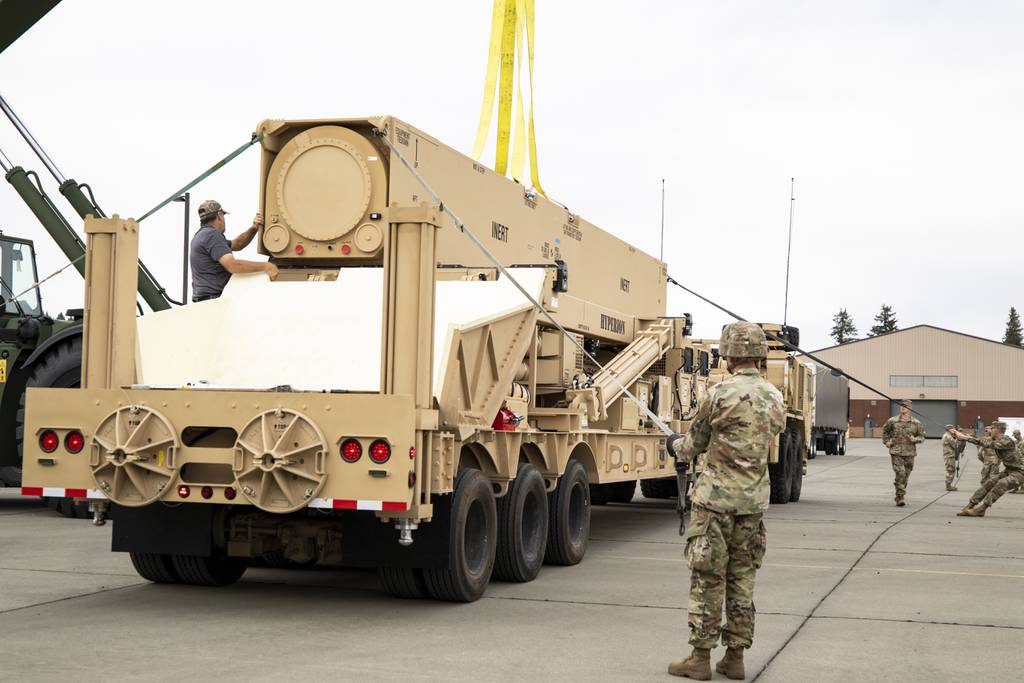HUNTSVILLE, Ala. — The U.S. Navy is heading into a major test of a hypersonic weapon that will help determine the way ahead for a joint development program with the U.S. Army, according to the Army’s Rapid Capabilities and Critical Technologies Office director.
“The Navy is moving forward on their test, which isn’t a launch out of ground support equipment, but just off a stool launch, so we get another look at the missile,” Lt. Gen. Robert Rasch told Defense News in a March 27 interview here at the Association of the U.S. Army’s Global Force Symposium.
The Navy’s test of the Common-Hypersonic Glide Body will lead into an Army test of the missile in the summer from a ground-based launcher, he said. “Right now, if things go as planned, we’ll be out at the range this summer.”
Hypersonic weapons are capable of flying faster than Mach 5 — or more than 3,836 miles per hour — and can maneuver between varying altitudes, making them difficult to detect. The C-HGB is made up of the weapon’s warhead, guidance system, cabling and thermal protection shield.
The U.S. is in a race to field the capability as well as develop systems to defend against hypersonic missiles. China and Russia are actively developing and testing hypersonic weapons.
The test in the spring is focused solely on missile performance and is conducted using a test stand that eliminates ground support equipment, canister and launcher.
“It’s more of a command to the missile to ignite and watch the missile go through stage one, stage two, payload adapter, hypersonic glide body separating and do its thing,” Rasch said.
The test is to ensure the services understand the missile performs as intended, he said.
The Army, at the same time, is ensuring that the ground support equipment for its Long-Range Hypersonic Weapon, or LRHW, works correctly and will then marry up the missile and launcher in the later test, Rasch explained.
If the Navy test is successful, “that is a decision point for the Army to allow the vendor to begin putting those tactical rounds together. We’ve got them lined up, ready to go, in different stages of completeness,” Rasch said. The Army has been holding out in order to “see the end-to-end performance,” Rasch said.
The Army has spent several years working with Leidos’ Dynetics to build the industrial base for the hypersonic weapon glide body that will be used by both the ground service and the Navy because the domestic private sector had never built a hypersonic weapon.
The service also separately produced launchers, trucks, trailers and the battle operations center necessary to put together the first weapon battery. Lockheed Martin is the weapon system integrator for the Army’s hypersonic capability that will be launched from a mobile truck.
If the Army test is successful, Rasch said, the rounds will be ready to go to the first unit equipped with the capability.
The service completed its delivery of the first hypersonic weapon capability, minus the all-up rounds, to I Corps’ 5th Battalion, 3rd Field Artillery Regiment, 17th Field Artillery Brigade unit at Joint Base Lewis-McChord in Washington state two days ahead of its end-of-FY21 fielding deadline.
The original plan was to train on the equipment and receive those rounds in the fall of 2023, but based on a series of failed or aborted tests, that timeline has slid further down the road.
The Army and Navy last year had to abort flight tests in March, October and November due to “challenges at the range,” Rasch said.
“Every time we do these tests, even if it’s a no-test, obviously, we learn,” Rasch said. “But in this case, the round had to go back and get a little work done on it. These challenges weren’t with the round, but just the process of firing those up, it takes some work.”
The pause in testing while the rounds were evaluated, “gave us a little time to stop and kind of reflect on where we had not done enough developmental testing. Obviously a program that’s moving as fast as RCCTO has on hypersonics, there’s risk involved in going fast,” Rasch said. “You’re doing acquisition and running with scissors at the same time.”
The Army looked at earlier component level testing and figured out where the service may have missed things, he added.
“And we’ve done a series of walk-ups over the last several months to try to make sure we understood exactly what is going on, what’s the phenomena going on and how do we replicate that repeatedly so we know that’s the error,” Rash said.
Even this week, Rasch said, the Army is conducting high-fidelity testing with the ground support equipment, simulating every aspect of the shot to make sure it’s captured “all the phenomena to allow us to get back out to the range.”
While the program is delayed, the speed at which the Navy and the Army are moving is extremely fast for a program of this nature, Rasch noted.
The service went from a blank piece of paper in March 2019 to delivering hardware in just over two years, including an operations center, four transporter-erector-launchers and modified trucks and trailers that make up the ground equipment of the LRHW.
“This is a hard problem. If you look at the history of missile programs, most of them in this space are 10 to 12 years in duration,” he said. “Not only is this a new missile, it’s a new technology of missile and, oh by the way, we had to build new ground support equipment, we had to build new command-and-control capabilities within it. So that was a monumental task.”
Jen Judson is an award-winning journalist covering land warfare for Defense News. She has also worked for Politico and Inside Defense. She holds a Master of Science degree in journalism from Boston University and a Bachelor of Arts degree from Kenyon College.








